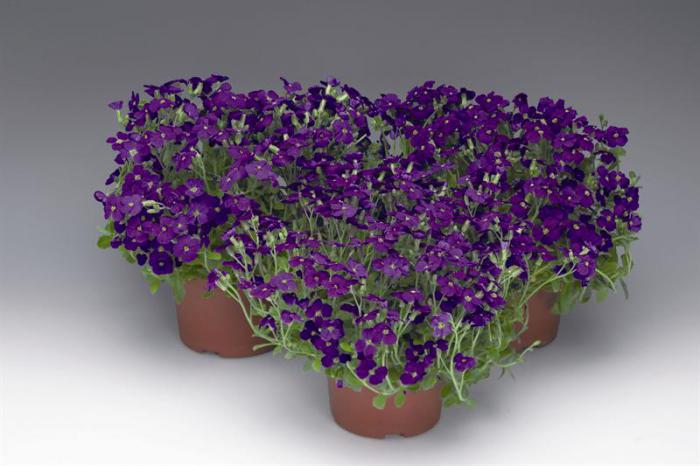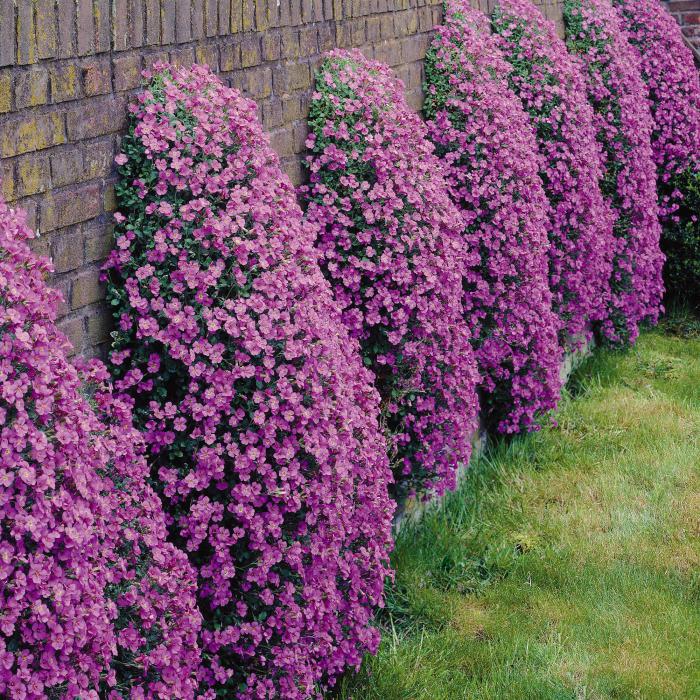Aubrieta belongs to the genus of flowering plants of the Cabbage family . It came to us from southern Europe and the Middle East (Iran, Asia Minor, Italy and Southern France). It has become widespread throughout Europe as a successful decoration of gardens and rock gardens. And the flower is named after the French artist Claude Aubrier, who was addicted to botanical illustrations. Let's find out what a good shave is? Planting and caring for this plant also will not remain out of our attention.
What does the shade look like?
These plants are characterized as evergreen, perennial and creeping. Their branches do not rise above 10-15 cm above the ground, forming expressive hemispherical jackets. The leaves are small, pubescent, with a serrated or whole edge, in shape resembling an ellipse or an egg, arranged one at a time, alternately. The plant looks spectacular at any time of the year, and even when it does not bloom, it still pleases the owners with green, juicy leaves. The flowers are four-petalled and small, not more than 1 cm in diameter, forming small racemose inflorescences. The genus has 12 species of plants that differ in the shade of the petals: red, pink, purple, blue, less often - white. Here she is so multicolor - she’s shaved. Photos of flowers presented in the article allow you to make your own opinion about this decorative plant.
Common types in Russia
The most popular cultural auret (Aubrieta x cultorum Bergmans), combining several varieties and forms that differ in the color of the petals. The shoots of the plant do not exceed 20 cm, the leaves are small, with serrated edges, scapular-oblong.
The flowers are small (about 1 cm in diameter), of various colors - from purple to dark purple. During flowering (about 40 days, from May to June), the leaves are not even visible under a dense layer of bright inflorescences. Varieties currently bred are characterized by larger petals, terry branches.
Aubrieta deltoidea is the ancestor of all hybrid varieties, as it bears fruit. Their lilac or purplish-blue friable racemose inflorescences please the eye for 30-35 days also in May. They are distinguished by more dissected deltoid gray-green leaves with a pair of teeth on each side.
Aubriet Flower: Choosing a Place to Plant
What place does this plant prefer? Necessarily sunny, partial shade is allowed only in a hot southern climate, and in moderate it will only bring harm: the auret will stretch and cease to bloom. The soil should be light, not too fertile. Fertilize it with ash, lime or chalk. Waterlogged clay and oily land with a high peat content should be avoided. In winter, moisture is simply fatal for flowers such as sheath. Planting and plant care are carried out in elevated areas, well-drained and rocky hills, in between the stones. Watering is required only for young plants, and then - only in a particularly arid time. Exceptions are southern areas, where the summers are very hot.
How to grow a colorful "rug"
Have you decided that your site should be decorated with aubriet? Planting and caring for the plant will cause you a lot of trouble, remember this. It can not be planted and stop monitoring development, otherwise very soon the flower will cease to fulfill its decorative function. There are three ways to multiply the Aubriet:

- Cuttings. Cut parts of plants are planted in a greenhouse, in soil from river sand and peat (in equal quantities). Many species are rooted in 95% of cases under conditions of artificial fog, and some varieties give roots only in 25%. At the end of August, rooted petioles are transplanted to a permanent place so that they take root there before the first frost. It is recommended that the distance between the bushes is 10-15 cm. The most valuable specimens are best left in the greenhouse until spring. Young plants are only frost-resistant in the first year of life and can easily tolerate cold, in the future it is advisable to carry out cuttings annually.
- Propagation by seed. They are sown in ridges in the open ground in the winter (in September). Be sure to mulch sand. Flowering occurs in the second year. Propagation is possible indoors: seeds are sown two months before the expected last freeze (from January to April). Vermiculite with seedlings is covered with a plastic film. When the seedlings sprout, the film is removed and after the frosts are planted in the soil in a permanent place. Note that when propagating the shave with seeds, varietal properties are not preserved.
- Reproduction by dividing the bush. It is made in rare cases in spring or autumn, if cuttings were not made or urgent need to move bushes. The plant reacts extremely painfully to such a procedure.
Care Features
For many summer residents and lovers of beauty guidance on personal plots, it will not be difficult to plant flowers of auret. Careful control of cultivation is also easy. But this does not need to stop, the plant requires constant care. Even if the soil on which the sheath grows is light enough, it is very useful to carry out surface sanding (mulching) with a layer of 3-5 cm 2-3 times per season. When flowering ends (in May or early June), the plant is pruned in order to facilitate rapid and compact growth in the future. In this case, in the fall you will again admire the colorful inflorescences. If the winter is forecast to be protracted, with sharp fluctuations in temperature, it is worth covering the shave with a dry leaf for this period.
Useful Tips
- Seeds should be bought in the spring, and when buying seedlings, pay attention so that the roots do not sprout from the holes in the bottom of the pot and are not intertwined.
- Manure and mineral nitrogen cannot be used as fertilizers (it reduces winter hardiness).
- Varieties with blue and violet petals are long-lived, but pink and red-flowered plants are pleasing to the eye for not so long.
- A flowering carpet on the edge of the curb or in rock gardens looks simply gorgeous. But this is far from the only way to design a site using a plant such as shaving. A cascade of bright inflorescences, descending along the fence or wall of the building, certainly causes amazement and admiration!
- Aubrieta goes well with other creeping plants: blue and violet flowers are planted with yellow rocky alissum, multi-colored milkweed, protruding white and Caucasian pink peck, base-leafed red soap dish. Pink and red harmonize with dwarf bearded irises, Douglas phlox or Pozharsky's bells.

Connoisseurs of floriculture will certainly find the right approach to the obrit plant. Planting and care will not cause them any particular inconvenience, and a bright carpet of small flowers will delight the hosts and impress guests.